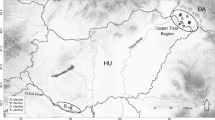Abstract
Woody vegetation, soils, age-diameter relationships and historical development are described for 18 gallery forest stands on Konza Prairie, a tallgrass prairie reserve in northeast Kansas. Detrended correspondence analysis (DCA) coupled with the importance values of dominant species was used to identify four stand types in these forests: Quercus muehlenbergii, Q. muehlenbergii-Q. macrocarpa, Q. macrocarpa-Q. muehlenbergii, and Celtis occidentalis-Q. macrocarpa. Location of these groups on the first DCA axis was correlated with decreasing slope and increasing percent silt (i.e. a moisture gradient from xeric to mesic). Shrub cover increased with droughtiness and decreased with both stand basal area and total reproduction.
Original Land Office Survey suggest a dramatic expansion of gallery forests along the stream channels and ravines during the period from 1859–1939. Further expansion occurred through 1978. Increases in woody vegetation were attributed to decreased fire intensity and frequency since European settlement. Q. macrocarpa and/or Q. muehlenbergii were the oldest and largest trees in each stand, but were poorly represented as young trees and seedlings. In contrast, Celtis occidentalis, Cercis canadensis and Ulmus spp. were well represented as young trees and were vigorously reproducing singly or in combination in all stands. The growth of these species into trees occurred 10 to 30 years after the major recruitment of Q. macrocarpa and Q. muehlenbergii into the tree size class. It is suggested that the oaks will be replaced by C. occidentalis on the more mesic sites and by C. canadensis on the more xeric sites. The potential of Ulmus spp. as an overstory dominant is probably limited by the Dutch Elm Disease.
Similar content being viewed by others
References
Abrams, M. D., 1985. Fire history of oak gallery forests in a northeast Kansas tallgrass prairie. Am. Mid. Nat. 114: 188–191.
Bellah, R. G. & Hulbert, L. C., 1974. Forest succession on the Republican River floodplain in Clay County, Kansas. The Southwestern Naturalist 19: 155–166.
Bragg, T. B. & Hulbert, L. C., 1976. Woody plant invasion of unburned Kansas bluestem prairie. Journal of Range Management 29: 19–24.
Brown, M. J. & Bark, L. D., 1971. Drought in Kansas. Kansas State University Agricultural Experiment Station Bulletin 547, 12 pp.
Cottam, G., 1949. The phytosociology of an oak woods in southwestern Wisconsin. Ecology 30: 271–287.
Cottam, G. & Curtis, J. T., 1956. The use of distance measures in phytosociological sampling. Ecology 37: 451–460.
Dahnke, W. C. (ed.), 1980. Recommended chemical soil test procedures for the north central region. North Central Regional Publication, Number 221, 33 pp.
Daubenmire, R., 1959. A canopy-coverage method of vegetational analysis. Northwest Science 33: 43–66.
Gauch, H. G., 1982. Multivariate Analysis in Community Ecology. Cambridge University Press, Cambridge, 298 pp.
Gleason, H. A., 1913. The relation of forest distribution and prairie fires in the middle west. Torreya 13: 173–181.
Grimm, E. C., 1983. Chronology and dynamics of vegetation change in the prairie-woodland region of southern Minnesota, U.S.A. New Phytol. 93: 311–350.
Higgins, K. F., 1984. Lightning fires in North Dakota grasslands and in pine-savanna lands of South Dakota and Montana. J. Range Manage. 37: 100–103.
Hill, M. O., 1979. DECORANA — A FORTRAN Program for Detrended Correspondence Analysis and Reciprocal Averaging. Ithaca, NY: Cornell University.
Hill, M.O. & Gauch Jr., H. G., 1980. Detrended Correspondence analysis: an improved ordination technique. Vegetatio 42: 47–58.
Komarek, Sr. W. V., 1968. Lightning and lightning fires as ecological factors. Tall Timbers Fire Ecology Conference 8: 169–197.
Kucera, C. L., 1960. Forest encroachment in native prairie. Iowa State J. Sci. 34: 635–640.
Penfound, W. T., 1962. The savanna concept in Oklahoma. Ecology 43: 774–775.
Pool, R. J., Weaver, J. E. & Jean, F. C., 1918. Further studies in the ecotone between prairie and woodland. University of Nebraska Studies 18: 1–47.
Pyne, S. J., 1983. Indian Fires. Natural History 2: 6–11.
SAS Institute Incorporated. SAS User's Guide: Statistics, 1982 ed. Cary, NC: 584 pp.
Sauer, C. O., 1950. Grassland climax, fire, and man. J. of Range Management 3: 16–21.
Stephens, H. A., 1969. Trees, shrubs and woody vines in Kansas. The Regents Press of Kansas, Lawrence. 250 pp.
Thompson, H. E., Willis, W. G. & Keen, R. A., 1978. Controlling dutch elm disease. Kansas State University Agricultural Experiment Station Bull. 626, 16 pp.
Ware, E. R. & Smith, L. F., 1939. Woodlands of Kansas. Kansas State College Agricultural Experiment Station Bull. 285, 42 pp.
Weaver, J. E., 1960. Flood plain vegetation of the central Missouri Valley and contacts of woodland with prairie. Ecol. Monogr. 30: 37–64.
Author information
Authors and Affiliations
Additional information
Botanical nomenclature follows Stephens (1969).
This research was supported by National Science Foundations Grant DEB 80-12166. I wish to thank L. C. Hulbert and G. R. Marzolf for the encouragement to study these communities and help in interpreting the results. M. L. Heinrich deserves special mention for his field assistance and M. E. Gurtz for his contributions in computer programming. Earlier drafts of the manuscript were reviewed and greatly improved by L. C. Hulbert, G. Cottam, E. S. Menges, K. T. Killingbeck and B. McCune.
Rights and permissions
About this article
Cite this article
Abrams, M.D. Historical development of gallery forests in northeast Kansas. Vegetatio 65, 29–37 (1986). https://doi.org/10.1007/BF00032124
Accepted:
Issue Date:
DOI: https://doi.org/10.1007/BF00032124




